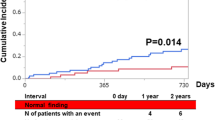Abstract
The prognostic value of a normal exercise thallium-201 scintigram was determined in 211 patients with a normal exercise and resting scintigram. Endpoints were sudden cardiac death, non-fatal acute myocardial infarction and coronary artery bypass grafting or percutaneous transluminal coronary angioplasty. Forty patients (19%) had a history of a previous myocardial infarction and 40 (19%) were known to have had a previous percutaneous transluminal coronary angioplasty or coronary artery bypass grafting. Sixty-four patients (31%) were on treatment with β-blocking agents. After a mean follow-up period of 23.5 months, 22 patients had had a cardiac event (1 cardiac death, 6 myocardial infarction, 15 revascularization). For the total group, the 1-year event rate for cardiac death, myocardial infarction, percutaneous transluminal coronary angioplasty or coronary artery bypass grafting was 7.0%. For cardiac death or myocardial infarction alone the event rate was 2.8%. The only parameter independently predictive for cardiac events was the regular use of β-blocking agents. The high event rate in patients on β-blocking treatment is partly due to the fact that these patients were more symptomatic for coronary artery disease. The sustained β-adrenergic blockade in this patient group, even in patients advised to stop medication, was suspected to interfere with the results of 201Tl scintigraphy. Therefore, more attention should be paid to patient instruction regarding the discontinuation of medication before the test.
Similar content being viewed by others
References
Bairey CN, Rozanski A, Maddahi J, Resser KJ, Berman DS (1989) Exercise thallium-201 scintigraphy and prognosis in typical angina pectoris and negative exercise electrocardiography. Am J Cardiol 64:282–287.
Brown KA (1991) Prognostic value of thallium-201 myocardial perfusion imaging. Circulation 83:363–381.
Brown KA, Boucher CA, Okada RD, Guiney TE, Newell JB, Strauss HW, Pohost GM (1983) Prognostic value of exercise thallium-201 imaging in patients presenting for evaluation of chest pain. J Am Coll Cardiol 1:994–1001.
Bruncin T, Edhag O, Lundman T (1976) Effects remaining after withdrawal of long-term beta-receptor blockade. Br Heart J 38:1065–1071.
Burns RJ (1991) Antianginal treatment and 201Tl scintigraphy. Circulation 84:2203.
Burns RJ, Kruzyk GC, Armitage DL, Druck MN (1989) Effect of antianginal medications on the prognostic value of exercise thallium scintigraphy. Can J Cardiol 5:29–32.
Hockings B, Saltissi S, Croft DN, Webb-Peploe MM (1983) Effect of beta adrenergic blockade on thallium-201 myocardial perfusion imaging. Br Heart J 49:83–89.
Kaul S, Finkelstein DM, Homma S, Leavitt M, Okada RD, Boucher CA (1988a) Superiority of quantitative exercise thallium-201 variables in determining long-term prognosis in ambulatory patients with chest pain: a comparison with cardiac catheterization. J Am Coll Cardiol 12:25–34.
Kaul S, Lilly DR, Gascho JA, Watson DD, Gibson RS, Oliner CA, Ryan JM, Beller GA (1988b) Prognostic utility of the exercise thallium-201 test in ambulatory patients with chest pain: comparison with cardiac catheterisation. Circulation 77:745–758.
Kiat H, Berman DS, Maddahi J, De Youang L, Van Train K, Rozanski A, Friedman J (1988) Late reversibility of tomographic myocardial thallium-201 defects: an accurate marker of myocardial viability. J Am Coll 12:1456–1463.
Kiat H, Maddahi J, Roy LT, von Train K, Friedman J, Resser K, Berman DS (1989) Comparison of technetium 99m methoxy isobutyl isonitrile and thallium 201 for evaluation of coronary artery disease by planar and tomographic methods. Am Heart J 117:1–11.
Koss JH, Kobren SM, Grunwald AM, Bodenheimer MM (1987) Role of exercise thallium-201 myocardial perfusion scintigraphy in predicting prognosis in suspected coronary artery disease. Am J Cardiol 59:531–534.
Niemeyer MG, Zwinderman AH, Cramer MJ, Wall van der EE, Verzijlbergen FJ, Breeman A, Ascoop CA, Pauwels EKJ (1990) Improvement of diagnosis in the non-invasive assessment of coronary artery disease: enhanced evaluation of quantitative exercise 201-thallium imaging by multivariate analysis. Cardiovase Res 24:804–812.
Oosterhuis WP, Zwinderman AH, Kuijper AF, Breeman A, Niemeyer MG (1991) Prognostic value of thallium-201 myocardial scintigraphy (letter). Circulation 84:2203.
Pamelia FX, Gibson RS, Watson DD, Craddock GB, Sirowathka J, Beller GA (1985) Prognosis with chest pain and normal thallium-201 exercise scintigrams. Am J Cardiol 55:920–926.
Pohost GM, Boucher CA, Zir LM (1979) The non-invasive stress test: the qualitative approach revisited (abstract). Circulation 60 [Suppl II]:II-149.
Rigo P, Bailey IK, Griffith LSC (1980) Value and limitations of segmental analysis of stress thallium myocardial imaging for localisation of coronary artery disease. Circulation 61:973–981.
Rijneke RD, Ascoop CA, Talmon JL (1980) Clinical of upsloping ST segments in exercise electrocardiography. Circulation 61:671–678.
Sheffield LT, Holt JH, Reeves TJ (1965) Exercise graded by heart rate in electrocardiographic testing for angina pectoris. Circulation 32:622–629.
Staniloff HM, Forrester JS, Berman DS, Swan HJC (1986) Prediction of death, myocardial infarction, and worsening chest pain using thallium scintigraphy and exercise electrocardiography. J Nucl Med 27:1842–1848.
Steele P, Sklar J, Kirch D, Vogel R, Rhodes CA (1983) Thallium-201 myocardial imaging during maximal and sub-maximal exercise: comparison of sub-maximal exercise with propranolol. Am Heart J 106:1353–1357.
Verzijlbergen JF, Cramer MJ, Niemeyer MG, Ascoop CAPL, van der Wall EE, Pauwels EKJ (1991) 99Tcm-SESTAMIBI for planar myocardial perfusion imaging; not as ideal as the physical properties. Nucl Med Commun 12:381–391.
Wackers FJT, Russo DJ, Russo D, Clements JP (1985) Prognostic significance of normal quantitative planar thallium-201 stress scintigraphy in patients with chest pain. J Am Coll Cardiol 6:27–30.
Author information
Authors and Affiliations
Rights and permissions
About this article
Cite this article
Oosterhuis, W.P., Breeman, A., Niemeyer, M.G. et al. Patients with a normal exercise thallium-201 myocardial scintigram : always a good prognosis?. Eur J Nucl Med 20, 151–158 (1993). https://doi.org/10.1007/BF00168876
Received:
Revised:
Issue Date:
DOI: https://doi.org/10.1007/BF00168876




